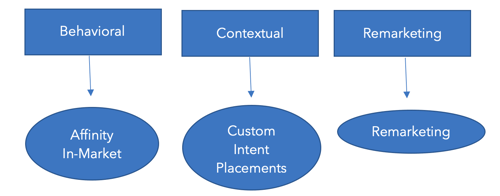The new numbers around YouTube—sparked by an increase in watch time during the pandemic—are notable for brands looking to drive a stronger digital game. In April, Google reported a 25% increase in watch time; by May, a quarter of U.S. adults said they had significantly increased their YouTube usage, the highest percentage for any social media platform. The vast majority of Americans consume YouTube content—74.2% of the population this year—and younger generations are particularly engaged. A recent study found that consumers perceive YouTube as the most entertaining, informative, engaging, creative, and trustworthy of all the platforms*. YouTube also stands out due to its lack of competition—it is the number one ad-supported OTT platform. As a Senior Digital Strategist at Stella Rising, I incorporate YouTube campaigns into our clients’ digital media plans for all these reasons and more. In this overview of what to expect when advertising on the platform, I describe the types of targeting that can be done and the scenarios to which they are best applied.
AUDIENCE TARGETING: AN OVERVIEW
Across the suite of Google products (SEM, Google Display Network, YouTube, etc.), campaign targeting can be refined beyond demo and geo targeting with an added layer of audience targeting.
Campaign targeting varies by each brand’s goals and objectives but a great starting place when developing a media plan is within Google Analytics. As a Google property, GA collects site visitor data and buckets these users into the same groups that can be targeted in Google Ads.
- Behavioral audiences are groups of people pre-defined by Google with specific interest, user intent, and demographic information.
- Contextual targeting allows ads to be targeted to users based on the keywords they are actively searching, the content of the websites they are visiting, and specific YouTube videos or channels they are watching.
- Remarketing audiences are custom groups that allow advertisers to re-engage users that have watched a video (organically or paid), visited the site, purchased from the brand before and more.
MORE ABOUT AUDIENCE TARGETING: GROUPS
- Campaign Audience – Affinity: Top-funnel behavioral targeting based on a user’s interests, passions, and habits. Affinity targeting offers massive reach, scale, and strong efficiency. Affinity is great for awareness but does not drive as much consideration as other targeting methods such as In-Market or custom intent.
- Audience Examples: 30 Minute Chefs, Health and Fitness Buffs, Green Living Enthusiasts, Avid Investors, Movie Lovers
- Campaign Audience - In-Market: Mid-funnel behavioral targeting based on products and services that a user is actively researching; consumer indicates purchase intent. In-Market targeting reaches highly qualified users with large reach and scale while driving higher consideration.
- Audience Example: Fine Jewelry, Wedding and Engagement Rings, Face Makeup, Perfumes and Fragrances, Cooking and Baking Ingredients
- Campaign Audience - Custom-Intent: Target consumers currently researching specific topics, products, or services. Custom-Intent campaigns allow targeting to be more specific than the pre-defined Affinity and In-Market campaigns because this method is based on keywords identified in keyword research. Depending on the keyword set, reach and scale can be limited. Additionally, there is little insight into which keywords are resonating most with ad viewers so building out each custom intent audience by theme is important.
- Audience Example: For a Stella CPG client, the ad focus was the product, but we also presented various ads with recipes using the featured product. Custom-Intent allowed us to pursue users searching for specific recipe videos on YouTube and show ads as pre-roll video.
- Campaign Audience – Placements: Target specific channels or videos on YouTube. Placements can perform well but are typically quite dependent on the focus of the video ad. When the video ad contains a specific influencer, for example, we can target the users who are watching videos of that same influencer’s YouTube channel. When an influencer is not in the ad, however, we typically see lower view rates than any other audience targeting group. This is also typically the most expensive strategy.
- Campaign Audience – Topics: Target users based on the types of sites, apps, and videos they are visiting/engaging with. This targeting method allows for additional reach and scale while targeting YouTube content and having insight into how each topic bucket performs—unlike Custom-Intent.
- Audience Example: Targeting the “Cooking and Recipes” topics will show an ad to people watching cooking and recipe videos as well as visiting web pages and apps around cooking (which is less specific than placements).
- Campaign Audience – Remarketing: Re-engage site visitors, viewers of owned and operated channels/videos (both organic and paid) and past purchasers. This method allows marketers to re-engage users for better ad/brand recall while pushing them down the funnel. Remarketing via YouTube allows for specific audience lists, while offering the chance to tell a story through paid video ads due to sequential messaging.
Setting up campaigns separately by each targeting audience allows for more granular insight into which strategies work best. Separate campaigns make pivoting budgets easier to get the most out of every dollar spent. This campaign approach can drive outstanding performance, as seen from a recent YouTube Brand Lift studies for a CPG client which resulted in:
- 6% lift in Ad Recall (Best in Class)
- 5% lift in Brand Awareness (Best in Class)
- 6% lift in Consideration (High Average)

*Includes Pinterest, Instagram, Facebook, Snapchat, and TikTok
Additional Sources: Google, eMarketer, "US YouTube Advertising 2020," 20 November 2020


COMMENTS